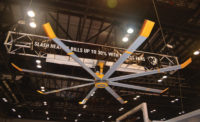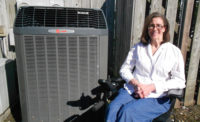CHICAGO — The threat of increasingly stringent federal regulations is heating up the hydronics market as manufacturers unveil high-efficiency equipment in preparation of the pending government-initiated efficiency benchmarks.
Tube Time
Barry Campbell, vice president, advertising and media relations, Aquatherm, said the industry is embracing polypropylene products. “Up until this year, very few polypropylene products were approved for heating and air conditioning applications,” he said. “Now, we’re seeing an abundance of polypropylene pipe. There’s also more acceptance of polypropylene for radiant heating and some radiant cooling, as well. And, it’s still an innovative process.”
At the expo, Aquatherm showcased its Straight Copper Stub-out, which allows for a quick, threadless transition from polypropylene to copper sweated connections. The stub-outs come in ½-, ¾-, and 1-inch diameters, and are 11-, 11-, and 18–inches long, respectively. Installers can easily transition to a fancoil unit, zone valve, heat pump, or other HVAC component with sweated connections using polypropylene.
According to Marc Heffner, director of marketing, Lochinvar LLC, many projects are opting for fire tube technology over water tube technology.
“Fire tube is a lot easier to install, and it’s a lot more of a forgiving installation,” Heffner said. “As the water passes through the water tube, you lose a lot of pressure. You have to add expensive pumps to build that pressure back up. In fire tube technology, you hardly lose any pressure at all, so you have less expensive pumps.”
Lochinvar showcased its FTXL™ Fire Tube Boiler, which earned the manufacturer an honorable mention in the 2015 AHR Expo Innovation Awards’ Heating category. The line delivers up to 10:1 turndown and features five models ranging 399,999-850,000 Btuh and 97-98 percent thermal efficiency. The FXTL also has remote connect capability for control anywhere at any time.
“People are waking up,” said Ingrid Mattsson, director of advertising and brand management of Uponor Inc. “Before, they didn’t know there were PEX opportunities and other alternatives to copper or CPVC [chlorinated polyvinyl chloride] installations available. So, we’re pretty excited about that.
“We’ve been doing this for a long time with radiant cooling and heating systems, but hydronic piping is fairly new over the last five years or so. It’s gaining traction, we’re growing, and a lot of people are really excited, sort of in the same way they moved from copper in the residential world to this. So, we’re pushing educational awareness. We’re out there talking to engineers all day long.”
Uponor showcased its new code-listed ProPEX Lead-free (LF) Brass Commercial Ball Valves for PEX-to-PEX connections in plumbing and hydronic distribution applications during the AHR Expo. The full-port valves are available in ½- to 2-inch sizes and are listed to ASTM F1960, NSF 14/61, NSF 359, and the Uniform Plumbing Code (UPC). The valves feature blowout-proof stems and are available with stem extension kits to accommodate up to 2 inches of insulation in insulated piping applications.
Efficiency Gains
Bell & Gossett, a Xylem Inc. brand, is redesigning its core product line to provide greater pump efficiencies. Mark Handzel, vice president of regulatory affairs and director of HVAC applied water systems, Xylem Inc., served on a working group that made recommendations to the Department of Energy (DOE) on how to handle implementing regulations that will mandate how manufacturers reach a certain level of efficiency, which he says is now in its final stage of review.
“We’re not going to try to give you just a little more efficiency, we’re going to give you the very best,” Handzel said. “The redesign is preemptive to these regulations. For us, it was an opportunity to redesign using the most advanced tools available to get the best performance of our products and to also look at metallurgy changes that would provide longer durability at those higher-efficiency levels. There’s a lot of wear on parts in a pump. You’re constantly pushing water through, and water eventually wears things out. So, changing to stainless steel impellers provides us with efficiency and durability that lasts 15-20 years.”
Bell & Gossett launched its Series 60 and Series e-09 in-line pumps with ECMs, which offer customers quiet, highly efficient, dry rotor motor technology performance in a small footprint.
Bosch Thermotechnology Corp. unveiled its sealed-combustion, high-efficiency stainless steel boiler line with condensing technology. The SSB family consists of eight models in four separate housing sizes with inputs ranging 85-1,024 MBtuh, applicable for use in small studio units to commercial buildings. The boilers, which can be cascaded, feature a stainless steel heat exchanger and low-gas-pressure operation. They can be vented using either polyvinyl chloride (PVC), CPVC, or polypropylene (PP).
“Most contractors and homeowners are looking for highly efficient, low-cost condensing boilers and hot water heaters,” said Craig Lazinsky, marketing program manager, Bosch Thermotechnology. “They’re looking for the most comfort at the highest efficiency.”
Stacey Gearhart, director, product and channel marketing, water heater division, Rheem Mfg. Co., said the market is partly driven by regulations, which will ultimately result in higher-efficiency equipment.
“As people become more and more aware of some of these higher-efficiency product categories, you’ll start to see more and more of a push into those higher-efficiency areas. We have several platforms that deliver those higher efficiencies, on the condensing platforms and on our tankless platforms, and we’re seeing growth there. We’re seeing an opportunity for people who want to save more energy and money in their homes. We expect that to continue to grow.”
“The industry and consumers are embracing high-efficiency circulators and pumps,” said Mark Chaffee, vice president, brand marketing, Taco Inc. “ECM is the most commonly used term, and we’re seeing an increase in variable-speed pumping, the integration of total system energy, and awareness of total system energy usage. We’re really on the leading edge of application-based hydronic design. Unique systems like our LOFlo and Loadmatch can dramatically make it easier to use hydronics for heating and cooling systems. And, it’s really kind of a must for green building design.”
Taco’s expanded ECM, wet-rotor, high-efficiency Viridian line includes VR1816 (18 feet of head and up to 16 gpm flow), VT2218 (22 feet of head and up to 18 gpm flow), and the VR3452 (34 feet of head and up to 52 gpm flow).
Radiant heating and cooling — in both commercial and residential applications — are in high demand, said Dave Desjardins, product manager, heating and cooling, Viega LLC.
“There’s definitely been a big interest in radiant heating and cooling, specifically for commercial use,” he said. “A lot of people see a system for heating, and, obviously, they’re a lot more comfortable with the heating side, but there’s more and more interest on the radiant cooling side as well — specifically in markets with dryer weather climates, like California.”
Desjardins said the retrofit market is up and coming on the residential side, as well. Simplification and cost are key drivers that factor into homeowners’ decisions on whether to jump on the radiant heating and cooling bandwagon.
“People are looking for simplification when it comes to radiant,” he continued. “They’re looking for solutions that can encompass a lot of things, but they’re looking for simplification. In residential, there was a downturn when the economy tanked, but, now, it’s coming back. And, while people are still very cost-conscious, when you look at putting together a whole system, it’s definitely very economical.”
Publication date: 2/23/2015
Want more HVAC industry news and information? Join The NEWS on Facebook, Twitter, and LinkedIn today!













